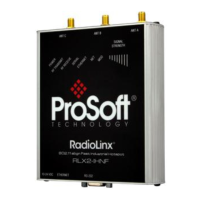RLX2 Series ♦802.11a, b, g, n Antenna Configuration
Industrial Hotspots User Manual
ProSoft Technology, Inc. Page 135 of 161
May 8, 2013
9 Antenna Configuration
In This Chapter
Antennas ............................................................................................. 135
9.1 Antennas
Connecting antennas to the radio, see Connecting Antennas (page 41).
Consider important electrical characteristics when selecting antennas:
Antenna pattern (page 135)
Antenna gain (page 136)
Antenna polarity (page 136)
Antenna location, spacing, and mounting (page 141)
9.1.1 Antenna Pattern
Information between two wireless devices is transferred via electromagnetic
energy radiated by one antenna and received by another. The radiated power of
most antennas is not uniform in all directions and has varying intensities. The
radiated power in various directions is called the pattern of the antenna. Each
antenna should be mounted so that its direction of strongest radiation intensity
points toward the other antenna or antennas with which it will exchange signals.
Complete antenna patterns are three-dimensional, although often only a two-
dimensional slice of the pattern is shown when all the antennas of interest are
located in roughly the same horizontal plane, along the ground rather than above
or below one another.
A slice taken in a horizontal plane through the center (or looking down on the
pattern) is called the azimuth pattern. A view from the side reveals a vertical
plane slice called the elevation pattern.
An antenna pattern with equal or nearly equal intensity in all directions is
omnidirectional. In two dimensions, an omnidirectional pattern appears as a
circle (in three dimensions, an omnidirectional antenna pattern would be a
sphere, but no antenna has true omnidirectional pattern in three dimensions). An
antenna is considered omnidirectional if one of its two dimensional patterns,
either azimuth or elevation pattern, is omnidirectional.
Beamwidth is an angular measurement of how strongly the power is
concentrated in a particular direction. Beamwidth is a three dimensional quantity
but can be broken into two-dimensional slices just like the antenna pattern. The
beamwidth of an omnidirectional pattern is 360 degrees because the power is
equal in all directions.

